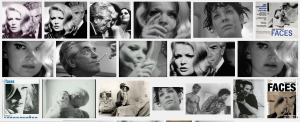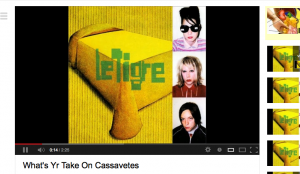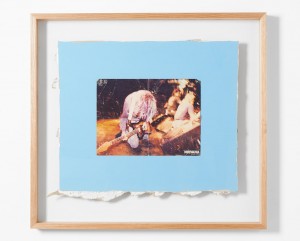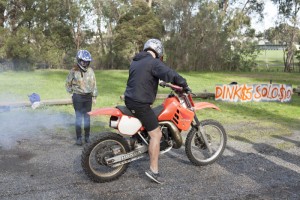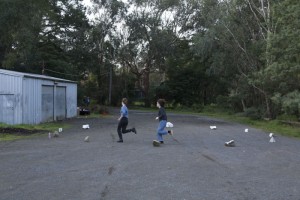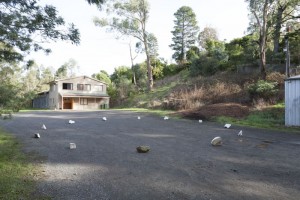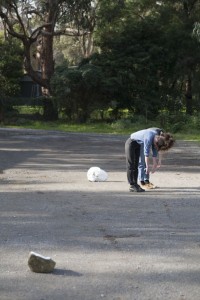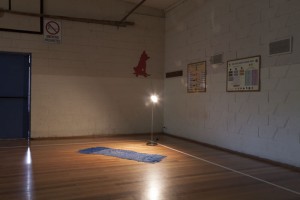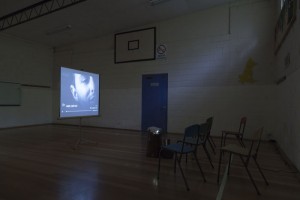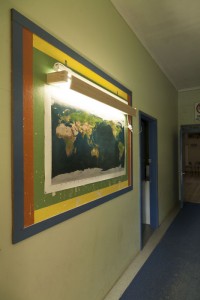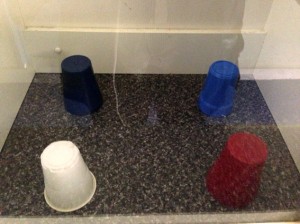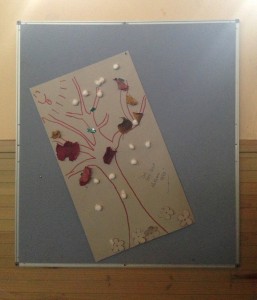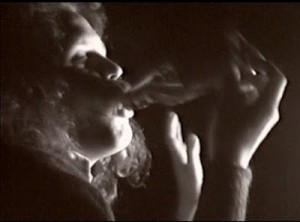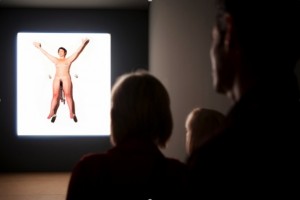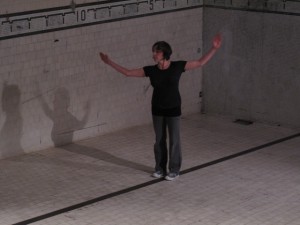Writing mail, writing class: ‘The big east’
It was kind of an awkward week or so.
At the opening for Simon Zoric’s exhibition What I can and can’t do and what I will and won’t do, after being kind of startled by his carved wooden effigy, I was walking away from one of his works where Zoric had basically cut out the wall from his teenage bedroom because it contained the beloved Nirvana poster that needed to be shown. I was walking and thinking, ‘is it really from his bedroom?’, ‘how’s that ’70s blue paint’, ‘what’s with Nirvana?’, ‘it’s the ’90s again’, ‘Fuck, Kurt committed suicide’, ‘shit, I hope Zoric doesn’t die’.
At the precise moment of that last thought, I kicked the silicone cast of his Cock & balls. Zoric’s self-depreciating humor, quite obviously contagious.
On Saturday just past, I went to see Christos Tsiolkas talk about Class and Culture at Trades Hall in Carlton. I guess, other than being called a hipster, my question about class and its invisibility or slipperiness re-emerged—does the approach to definition un-render representation?
Kiron Robinson’s 8-minute video When I write I write for you begins with a sniff and ends with awkward laughter. It’s an 8-minute close-up of a tightly framed face. Reminiscent of John Cassavetes’s 1968 film Faces.
The Le Tigre song ‘What’s your take on Cassavetes’ begins with a kind of drawling voice:
we’ve talked about it in letters
and we’ve talked about it on the phone,
but how you really feel about it,
I don’t really know.
Which, however obtuse, seems relevant here.
Robinson’s short film, mini-doc, foray into a kind of cinéma vérité aesthetic straddles a monologue about family relations, siblings, age gaps and role models, footy, responsibilities, time and scale issues, pornography, masculinity, hierarchies and the need for an inability to take sides.
Robinson exhibited the work in an exhibition he organised called The big east, which involved seven artists exhibiting in two Scout halls in Heathmont on Sunday June 9 between 10 am and 5 pm.
I asked Kiron some questions, the first being, could I ask him some questions:
LR: OK. I’m gonna start really simply. How did the idea for the show come about?
KR: About eighteen months ago I moved out here (outer eastern Melbourne). It is not my ideal location and resulted in odd sorts of pressures in my life. As a result, I decided to make some work out of being in the middle/outer suburbs. When I started looking around I noticed there were lots of psychologically interesting spaces in the suburbs that I had not noticed before. The Scout halls I used, are two that I pass by on a run. Over about eight months of running by them, an idea emerged of what I could do, so I decided to see if they were open to being used and it turned out they were. The rest just grew from there.
LR: What I found interesting about the project was the way in which it forced us out of the safety of the CBD. There is an inherent irony in this, especially if we consider all the ‘danger, drunk’ talk of the media, ‘mayhem on the weekends’ blah blah. You turned us into Sunday drivers without cars or something. All the obvious, by-chance visitors are kind of amazing as well. Having worked out there at one stage, I liked catching up with my old boss again and hanging out with his kids in his hood.
The Scout halls were these interesting spaces where ‘contemporary’ seemed irrelevant. I know we talked about the upturned coloured plastic cups; Daniel Belfield’s Map easily blending in with the in-situ pin board; your film projected on a stand (can’t remember the word for this thing!) as if ready for rope-knotting demonstration; Eliza Dyball’s performance which could have been a team-building exercise; the Ryan sisters hiding from the world double-self-portrait-sculpture could have been real-kids playing real-games (albeit slightly sinister) and Cormick’s dirt-bike dinks slip easily into hoon territory. How did you choose the artists for the exhibition? And did you specifically choose the Scout sites for these artists?
KR: Yes, it is nice to be out of the CBD. It changes things in terms of whatever our expectations or preconceptions of the suburbs are and alerts us to our conceptions of art. I am alerted to this every time I go home (as I live down the road from the Scout halls.)
I was really stunned when the first visitors came by. I think up until the point of someone arriving I had been unable to marry up these two parts of my life, art and where I live, and having people turn up acted as a catalyst or a clash which alerted me to my own awkwardness in relation to how I see my life.
The Scout halls came first. I chose them really thinking about my own works (selfish yes), but then invited the other artists because of a psychological aspect to their works which resonated with the sites. I knew of all their practices obviously and like them as people and so thought it would be a good combo.
LR: I am going to latch on to something there about ‘liking the artists as people’. It is something I am interested in in terms of momentum and criticality. In some ways, it is traditionally opposed to the very notion of critical because its first encounter is recognising subjectivity and in some ways, the sentimental.
When you said ‘I knew of all their practices obviously and like them as people and thought it would be a good combo’, what is it about the combination of artists? I know there is a space of not-knowing that we are working in, or aim to work in, but what were you hoping to achieve though the exhibition and the relationship between the works?
KR: Mmm.
I have curated/organised a number of exhibitions. Basically it is about working with people I am interested in. I see it as an extension of my practice in that I do things and make work about things that I am interested in. I am not really into curating for the sake of curating. As such i feel no obligation to criticality. Rather, like my own work I just want to do something that interests me first and hope that others can also connect in their own way. It is the way most artists work I think. It is nice, as you kind of just put your subjectivity front and centre.
It is the psychological aspect of the Scout halls, which I think reflects a deeper psychology of the suburbs, what lies beneath, that I was really interested in and that I was hoping to draw out. There is an intrinsic anxiety within the suburban, the anxiety of the aspirational and it leaks out in all sorts of ways. I think partly I recognise this within myself and moving back to the suburbs has really heightened it in me. Maybe for me it is not so much the aspirational but the settling. The giving up that I associate with a regression of returning to a suburban setting. I wanted to work with that. There is a romantic aspect to the suburban that I was interested in as well. The Sunday drive, the ideal that it sells. I just find them a very tense place.
Simon Zoric, What I can and can’t do and what I will and won’t do, West Space, Melbourne, 21 June – 13 July 2013.
The big east, 3rd Heathmont Scout Hall, Melbourne, 9 June 2013.
